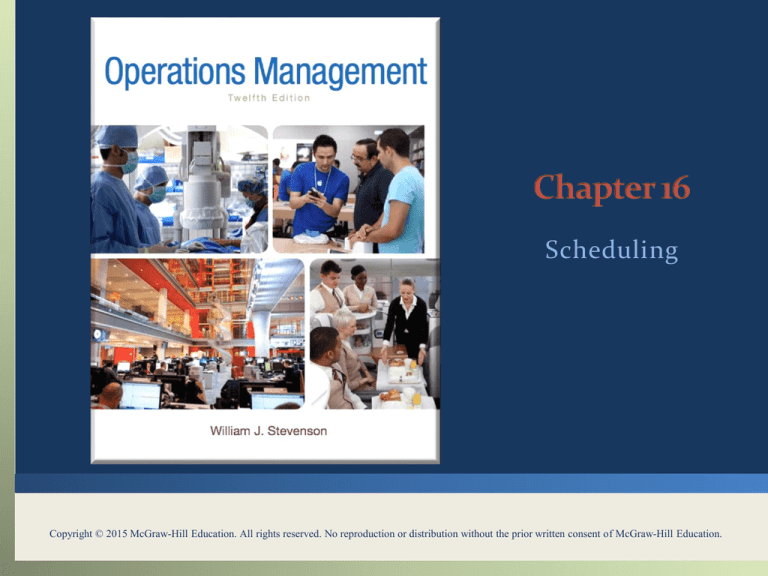
Scheduling
Copyright © 2015 McGraw-Hill Education. All rights reserved. No reproduction or distribution without the prior written consent of McGraw-Hill Education.
You should be able to:
LO 16.1
Explain what scheduling involves and the importance of good
scheduling
LO 16.2 Compare product and service scheduling hierarchies
LO 16.3 Describe scheduling needs in high-volume systems
LO 16.4 Describe scheduling needs in intermediate-volume systems
LO 16.5 Describe scheduling needs in job shops
LO 16.6 Use and interpret Gantt charts
LO 16.7 Use the assignment method for loading
LO 16.8 Give examples of commonly used priority rules
LO 16.9 Discuss the Theory of Constraints and that approach to scheduling
LO 16.10 Summarize some of the unique problems encountered in service
systems, and describe some of the approaches used for scheduling
service systems
16-2
Scheduling:
Establishing the timing of the use of equipment, facilities and
human activities in an organization
Effective scheduling can yield
Cost savings
Increases in productivity
Other benefits
LO 16.1
16-3
LO 16.2
16-4
Flow System
High-volume system in which all jobs follow the same
sequence
Flow system scheduling
Scheduling for flow systems
The goal is to achieve a smooth rate of flow of goods or
customers through the system in order to get high utilization
of labor and equipment
Workstation 1
LO 16.3
Workstation
2
Output
16-5
Outputs fall between the standardized type of output
of high-volume systems and the make-to-order output
of job shops
Output rates are insufficient to warrant continuous
production
Rather, it is more economical
to produce intermittently
Work centers periodically
shift from one product to
another
LO 16.4
16-6
Job shop scheduling
Scheduling for low-volume systems with many
variations in requirements
Make-to-order products
Processing requirements
Material requirements
Processing time
Processing sequence and setups
A complex scheduling environment
It is impossible to establish firm schedules until actual job
orders are received
LO 16.5
16-7
Load chart
A Gantt chart that shows the loading and idle times for a
group of machines or list of departments
LO 16.6
16-8
1.
Row reduction: subtract the smallest number in each row from
every number in the row
a.
2.
Column reduction: subtract the smallest number in each
column from every number in the column
a.
3.
Enter the result in a new table
Enter the result in a new table
Test whether an optimum assignment can be made
a.
b.
c.
LO 16.7
Determine the minimum number of lines needed to cross out all zeros
If the number of lines equals the number of rows, an optimum assignment is
possible. Go to step 6
Else, go to step 4
16-9
4.
If the number of lines is less than the number of rows, modify
the table:
a.
b.
c.
5.
6.
Subtract the smallest number from every uncovered number in the table
Add the smallest uncovered number to the numbers at intersections of cross-out
lines
Numbers crossed out but not at intersections of cross-out lines carry over
unchanged to the next table
Repeat steps 3 and 4 until an optimal table is obtained
Make the assignments
a.
b.
c.
LO 16.7
Begin with rows or columns with only one zero
Match items that have zeros, using only one match for each row and each column
Eliminate both the row and the column after the match
16-10
FCFS - first come, first served
SPT - shortest processing time
EDD - earliest due date
CR - critical ratio
S/O - slack per operation
Rush - emergency
LO 16.8
16-11
Theory of constraints
Production planning approach that emphasizes balancing
flow throughout a system, and pursues a perpetual five-step
improvement process centered around the system’s currently
most restrictive constraint.
Bottleneck operations limit system output
Therefore, schedule bottleneck operations in a way that minimizes
their idle times
Drum-buffer-rope
Drum = the schedule
Buffer = potentially constraining resources outside of the bottleneck
Rope = represents synchronizing the sequence of operations to
ensure effective use of the bottleneck operations
LO 16.9
16-12
Three important theory of constraints metrics:
Throughput
The rate at which the system generates money through sales
Inventory
Inventory represents money tied up in goods and materials used
in a process
Operating expense
All the money the system spends to convert inventory into
throughput: this includes utilities, scrap, depreciation, and so on
LO 16.9
16-13
Service scheduling often presents challenges not found
in manufacturing
These are primarily related to:
1.
The inability to store or inventory services
2. The random nature of service requests
Service scheduling may involve scheduling:
1.
2.
3.
LO 16.10
Customers
Workforce
Equipment
16-14
Scheduling customers: Demand Management
Appointment systems
Controls customer arrivals for service
Reservation systems
Enable service systems to formulate a fairly accurate estimate
demand on the system for a given time period
Scheduling the workforce: Capacity Management
Cyclical Scheduling
Employees are assigned to work shifts or time slots, and have days off,
on a repeating basis
LO 16.10
16-15








